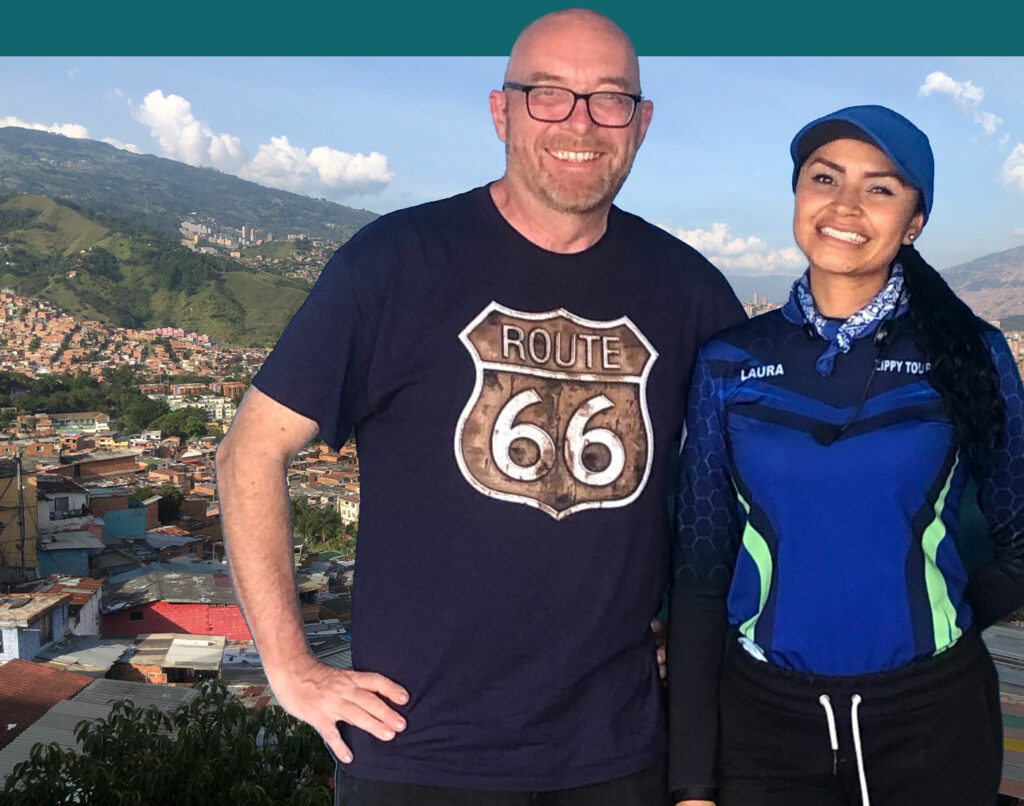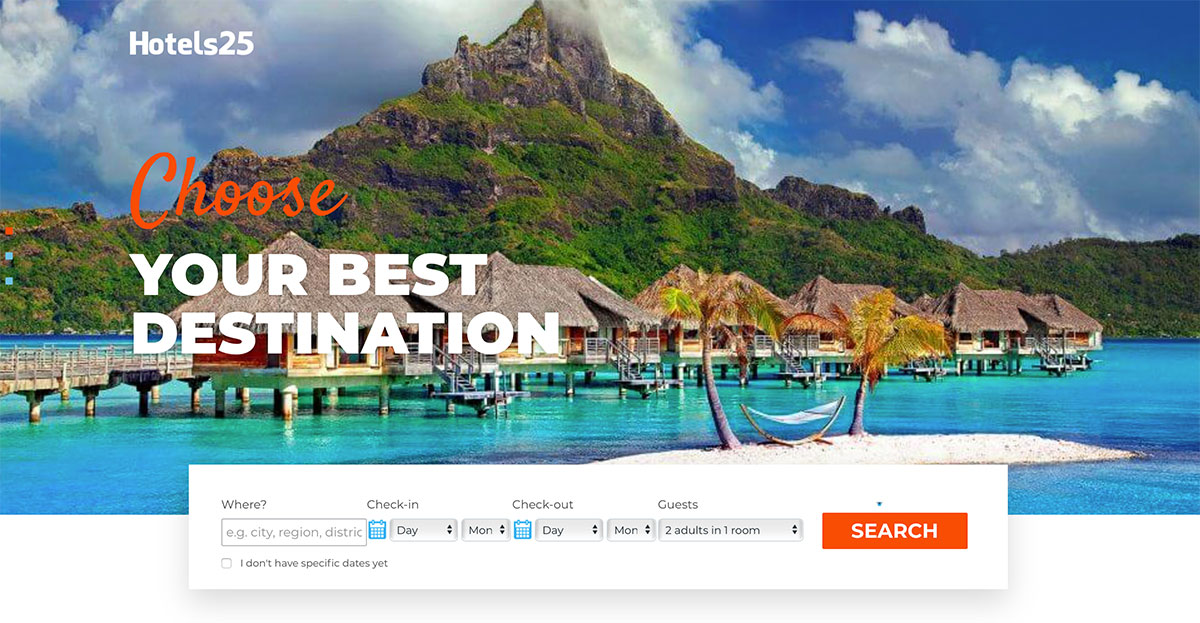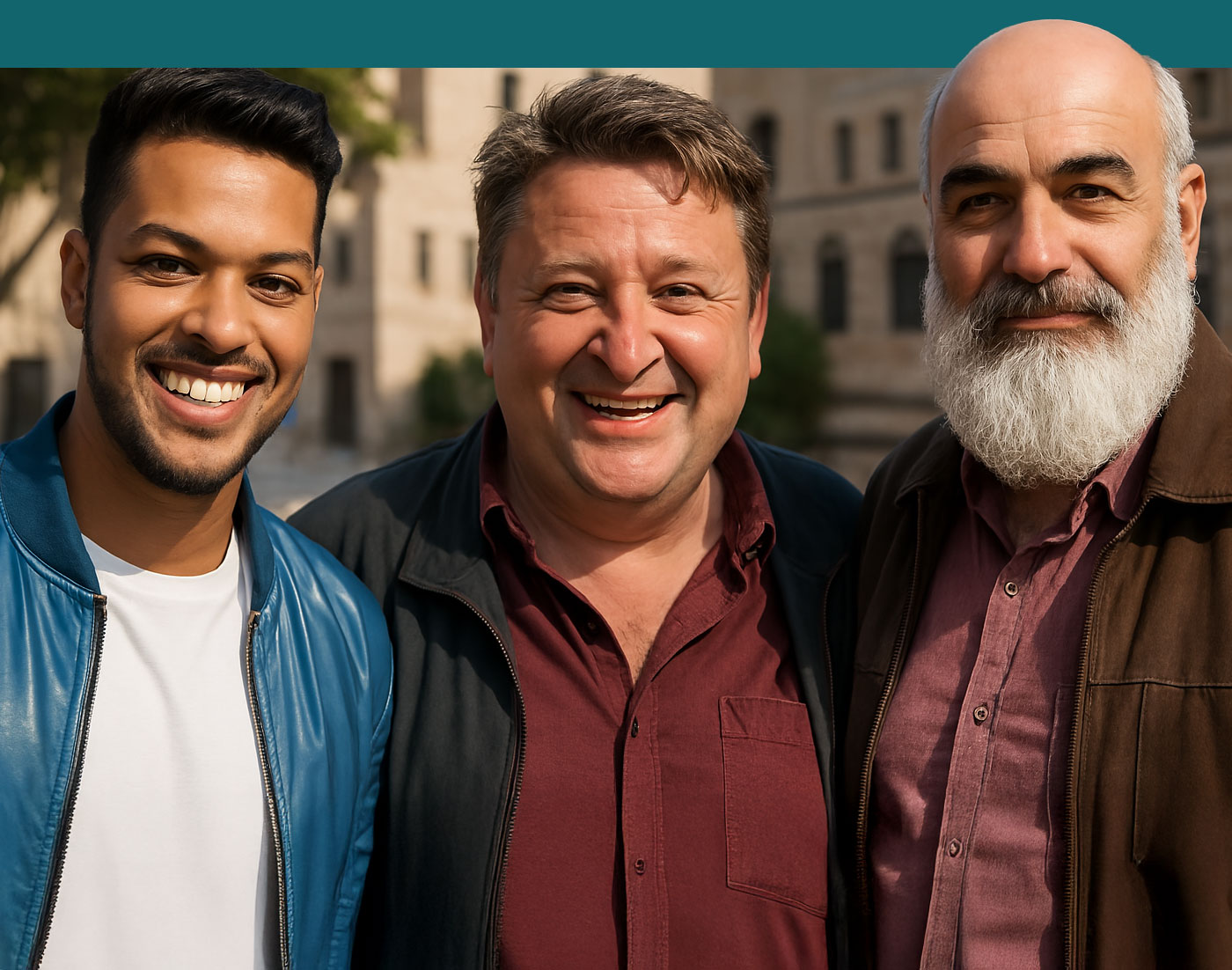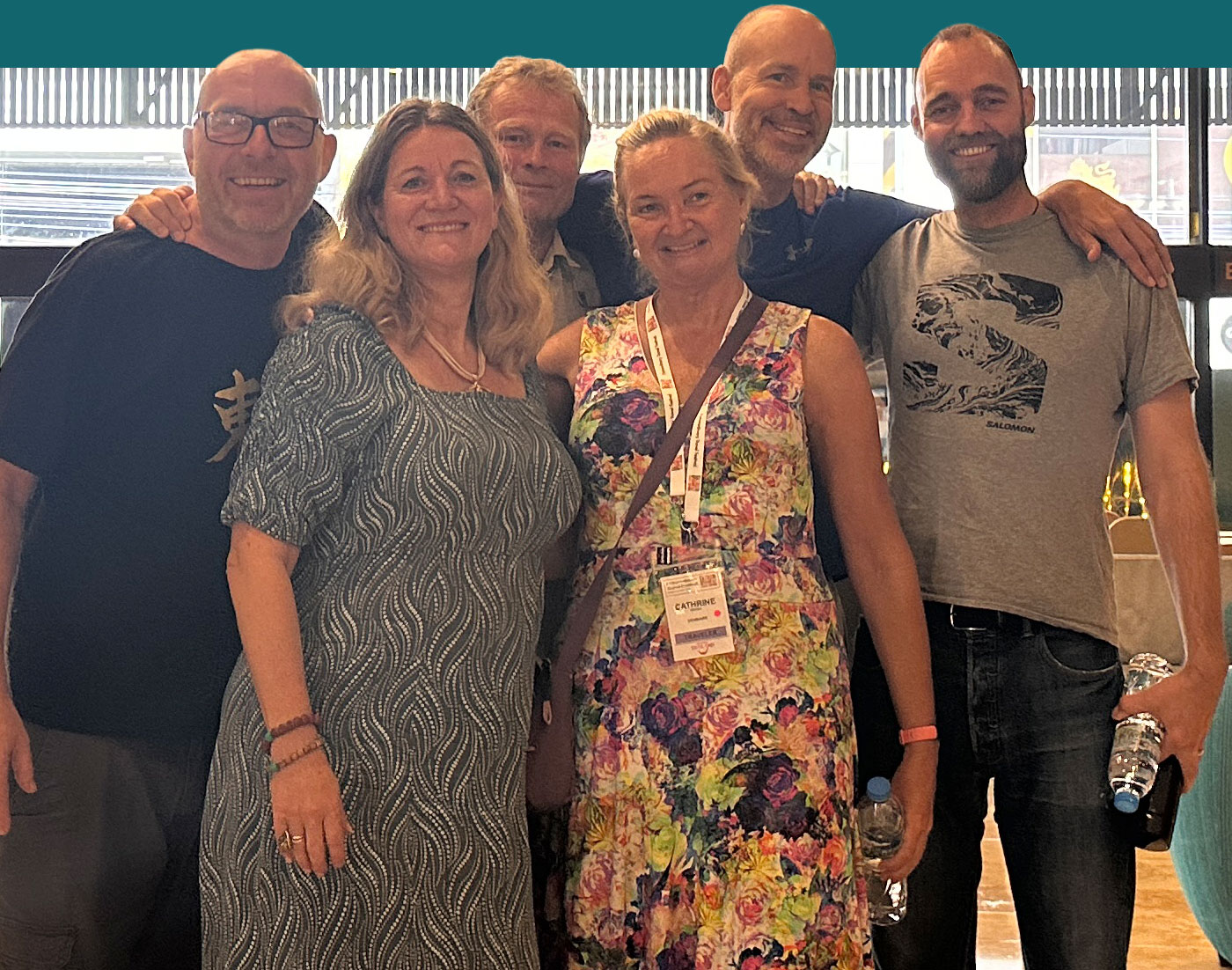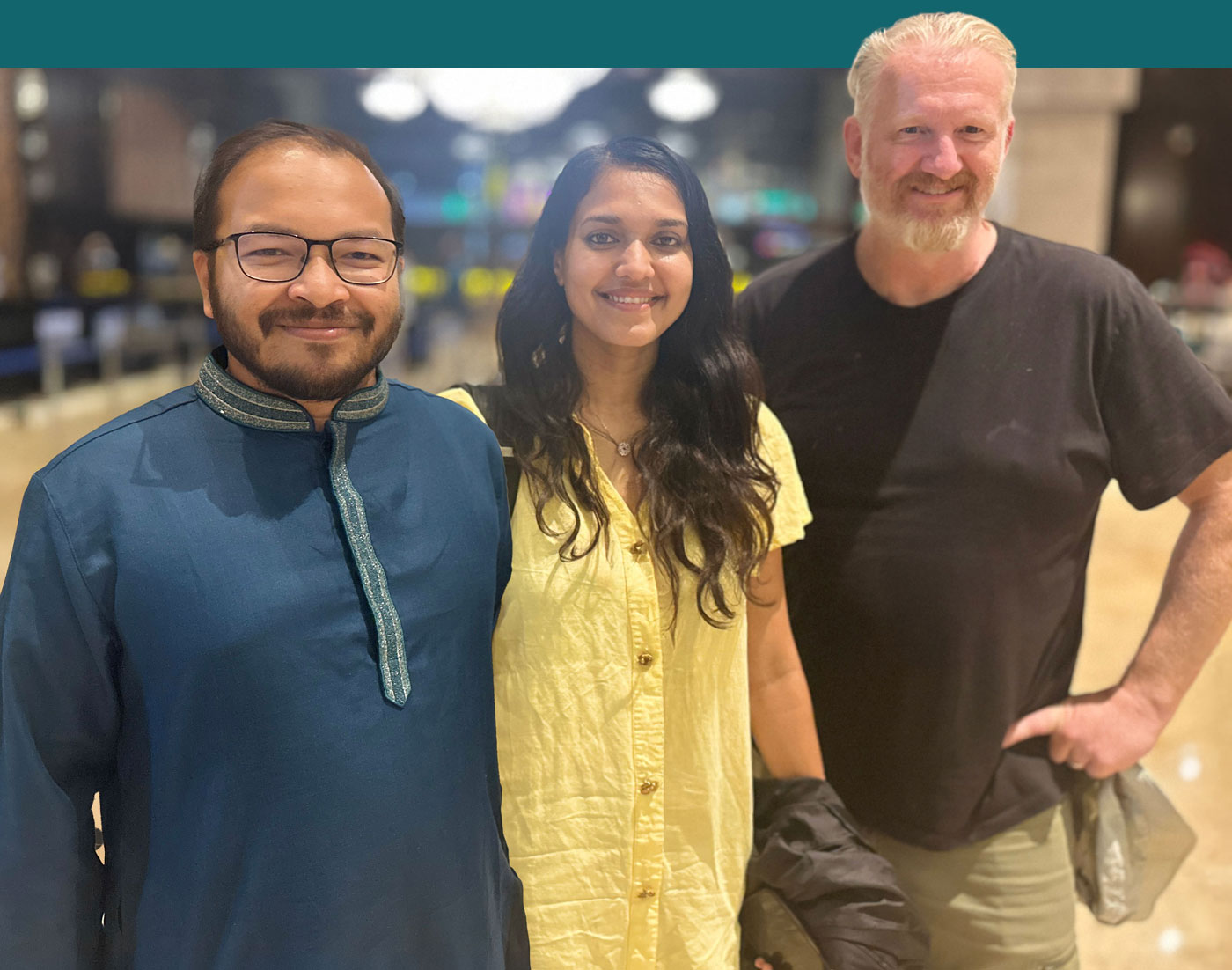3D/BINAURAL AUDIO
In parts of this episode, I used a special recording technique. Some call it binaural audio; some spatial audio and I normally just say 3D audio. This technique creates a three-dimensional audio effect that brings out so much more detail and depth than regular stereo (where the sound comes from only left and right). So, put on your headphones and give this episode a listen to get the full experience.
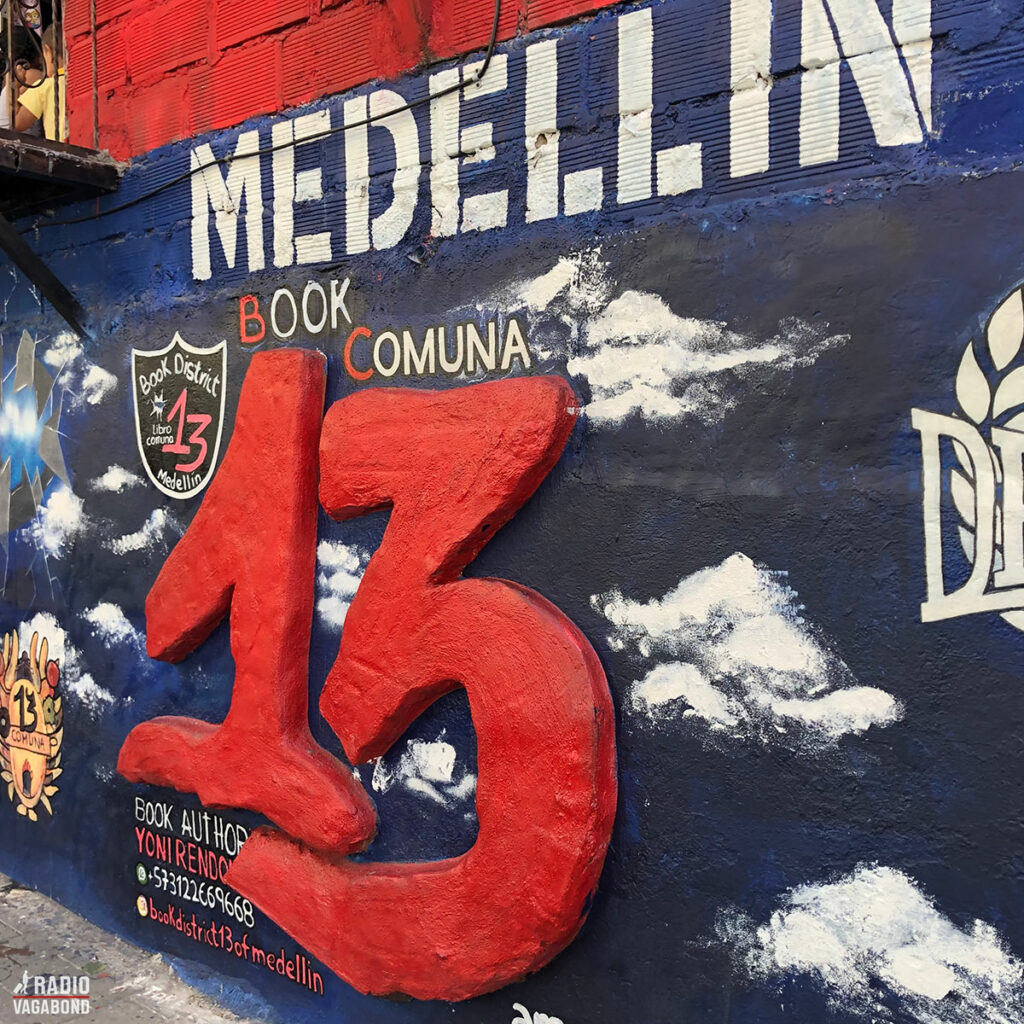
Levántate y brilla desde Colombia
Well, before I landed in Colombia, I had a few difficulties boarding my flight in Madrid, Spain. I wasn’t in a hurry to get on the plane as I already booked my seat online. So, to avoid standing in line, I just sat around until there were hardly any people left.
That turned out to be a mistake – and something that would almost make me miss my flight.
This is the story we’re starting with. Only so you can learn from my mistake. And there’s a solution to my problem and a great travel tip at the end of that.
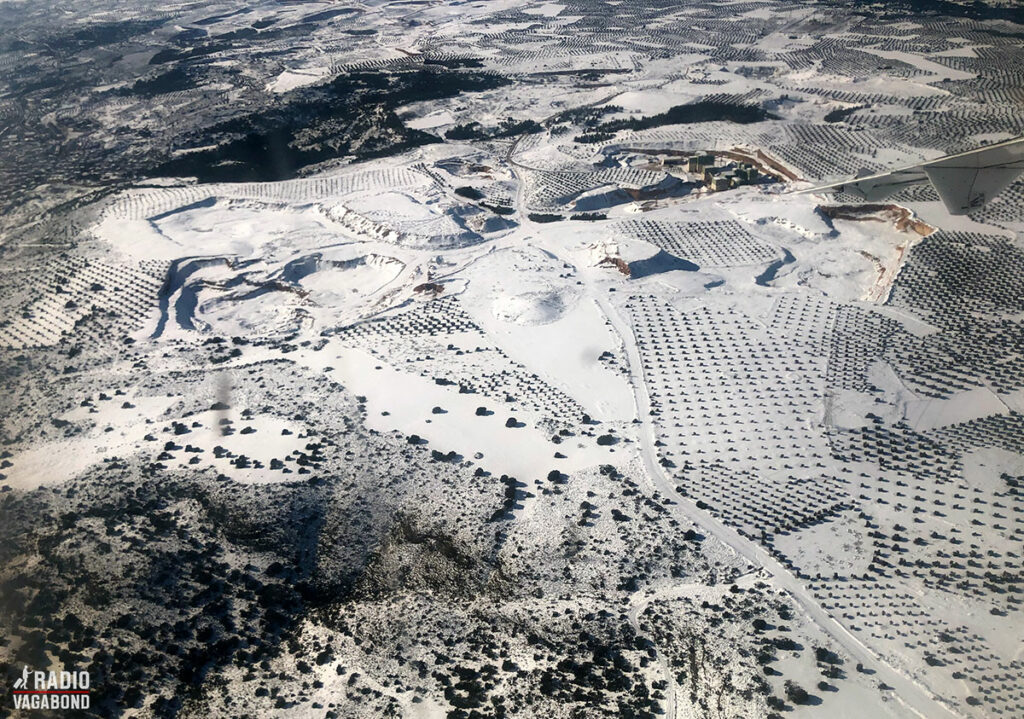
PRE-FLIGHT TURBULENCE
Prior to arriving at the airport, I made sure that I had everything in order. I got my Covid test, filled out all the immigration forms for entering Colombia and was pretty sure that I has everything sorted.
But then when I got to the gate (as one of the last people to board) I was asked for a return ticket or an onward ticket as proof that I wouldn’t overstay my visit in Colombia. And I didn’t have any of that.
I told the boarding gate official that I had visited the website of the government of Colombia and followed the steps described and nowhere did it say that I had to have a return or onward ticket. He said he was following orders, and that I had to buy either a return or onward ticket – right then and there.
Then, when he saw that I was one of the last in the line and he was about to close the gate, he just casually (without any empathy) said: “I suppose you cannot fly, sir”.
And then he spoke in Spanish to some of the other passengers in a similar situation. I was totally stressed out and quickly got on Skyscanner.com to desperately buy a ticket anywhere out of Colombia so he would let me on the plane. At the same time, worried that he would give my ticket to someone else.
To be honest this is such a rookie mistake from me. I’ve experienced a similar situation before in my time as a nomad. I guess I’ve just gotten a bit rusty during Covid…
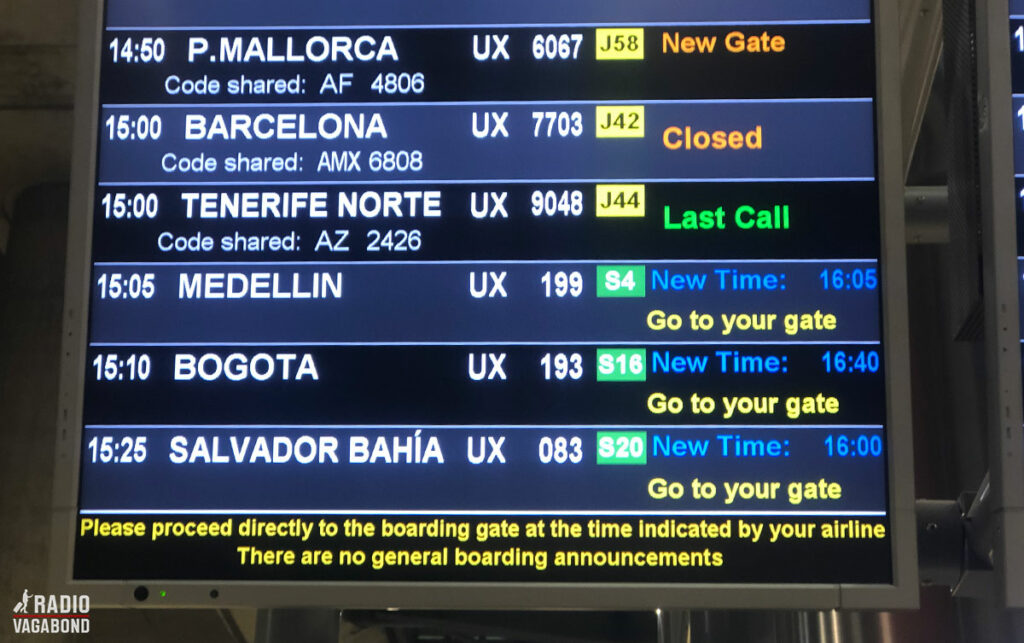
RADIO VAGABOND TRAVEL TIP #1
Not all, but some countries, do require that you have an onward ticket. Why is this?
Well, countries want to make sure that you don’t overstay the set amount of time you can be in their country. It’s also to prevent illegal immigration and also because they want to confirm that you have enough money to actually buy a ticket and leave the country. Honestly, these are all very valid reasons.
The airlines are held responsible and are required to check for proof of onward travel. They don’t always ask so you could be lucky and board without it. But my advice is don’t take that chance and end up like me: frantically trying to book an onward ticket on your phone just as they are closing the boarding gate.
ALL ABOARD…?
I went on Skyscanner and searched “Medellín, Colombia to anywhere” looking for the cheapest ticket. As I was stressing out trying to enter my credit card details on my phone, someone asked me if they could hotspot my phone just as the boarding gate official was asking me if I have checked a bag. Like he’s in a rush to get my bag out of the plane – as I’m obviously not going to fly.
And then he gets in an argument with the other passengers for the same issues as me which was adding to the already tense mood. Finally, my onward ticket to Panama got confirmed as I approached the tiny General of the Boarding Gate Republic.
My heart was racing. I didn’t want to get told that my onward ticket was somehow invalid and that I wouldn’t be able to board my flight.
Thankfully, he accepted my onward ticket and my ticket to board the flight, and I was off, not without exchanging a few terse words in his direction for the way the situation was handled.
RADIO VAGABOND TRAVEL TIP #2
There are ways to avoid getting in a situation like this. If you don’t know where you want to go and when you want to leave, you can find an airline that will let you refund and get your money back.
An easier option is to use Onward Ticket which allows you to “rent” a ticket for $12 which is valid for 48 hours. They send you a confirmation to show to the airline and then this onward ticket is cancelled once you have arrived.
NOT SO FAST, PALLE
When I eventually got on the plane and strapped my seatbelt it was 5.02 pm. Then 6 hours later, I was back inside the terminal…
Ice in the flight engine delayed our flight. We were asked to disembark a few times and had to wait for ages in the airport. This, of course, impacted my plans upon arrival, including arranging my meeting with my Airbnb host in Medellín.
I was expecting us to fly at around midnight. That didn’t happen. We waited another 5 hours before we were airborne. It seemed as though I would never reach Colombia…
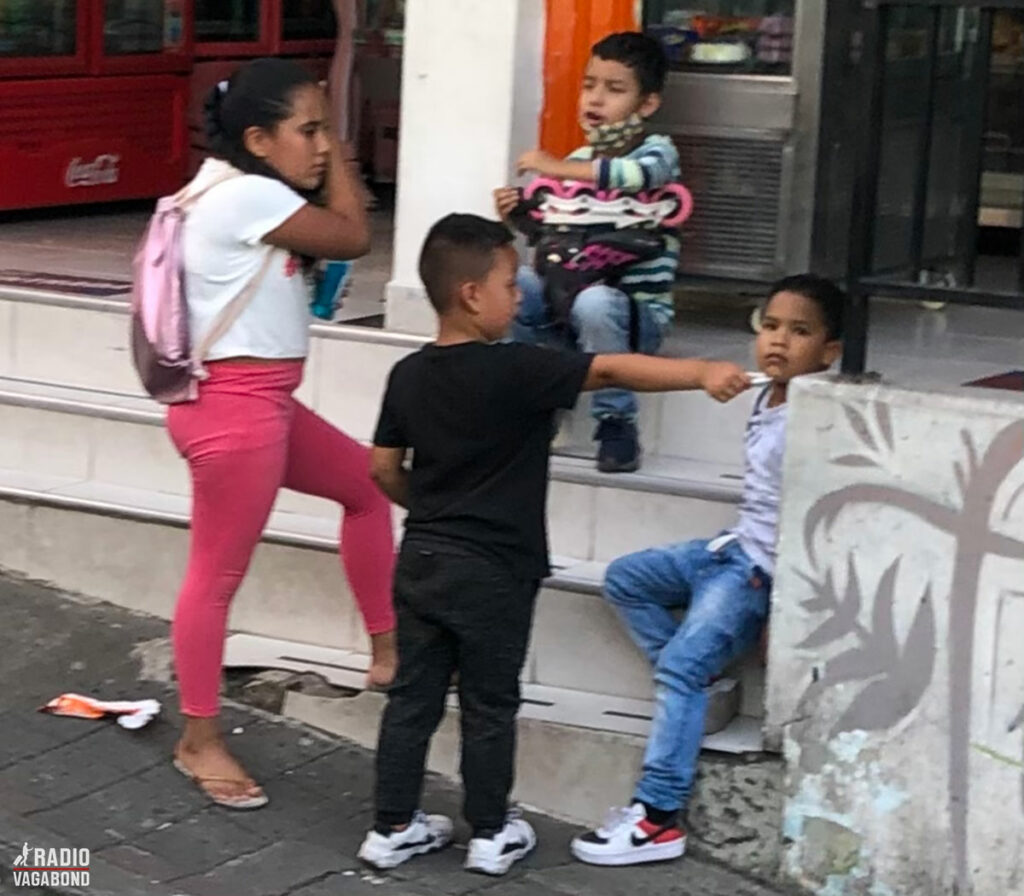
TOUCHDOWN IN COLOMBIA…FINALLY
We eventually arrived at 09.30 and went through immigration – without them asking to see an onward ticket. Go figure.
The good news was that I didn’t arrive in the middle of the night like I was worried about. But the driver (that my host Rob had sent) did. He’d been waiting for me since 3am.
Juan Pablo, the now slightly annoyed driver, only spoke Spanish and my Spanish definitely has room for improvement. So, one of the first things I did after I got settled in my apartment in Laureles in Medellín was to look for a Spanish class.
I found Alejandra and we ended up doing 3 one-ton-one classes every week for 3 months – even after I left Colombia.
She’s a really great teacher and makes it individual for each student. She knew I had a passion for producing podcasts, so one week my homework was to do a 2-minute podcast about Medellín in Spanish. You can listen to it after this week’s episode.
Drop me a line if you’re looking for a great Spanish teacher. I’d love to connect you with Alejandra.
7 INTERESTING FACTS ABOUT COLOMBIA
1. MEDELLÍN IS THE SECOND-LARGEST CITY IN COLOMBIA
After the capital Bogotá, Medellín is the second-largest city in Colombia. As of September 2019, the population of Medellín is about 2.5 million people (3.7 million in the metro area) and covers a total area of 381 square kilometres (147 square miles) and is 1,500 meters (4,920 feet) above sea level.
It’s located in the central region of the Andes Mountains in South America.
2. MEDELLÍN IS KNOWN AS THE CITY OF THE ETERNAL SPRING
That might be because the weather’s typically a perfect 70-75 °F (22-23 °C) no matter the season. So, flowers on balconies and terraces, in gardens and parks, on sidewalk café tables, bloom all year. It’s also known as “Capital of the Mountain”, and speaking of flowers it also has the nickname “City of the Flowers”.
3. CABLE CARS ARE USED FOR MASS PUBLIC TRANSPORT
Unlike expensive, touristy cable cars in other cities, the MetroCable here is a regular part of the city’s public transport system. And this was something they did before any other city in the world. So, while you’re cruising up high, you’ll be rubbing shoulders with locals heading home after work.
Medellín has an incredible skyline dotted with skyscrapers, grand colonial buildings, and colourful homes. And it looks extra good when you’re zipping over the scene in a cable car. And Lonely Planet describes the Medellín cable car system as “possibly the least expensive but most comprehensive and photogenic city tour in the world.”
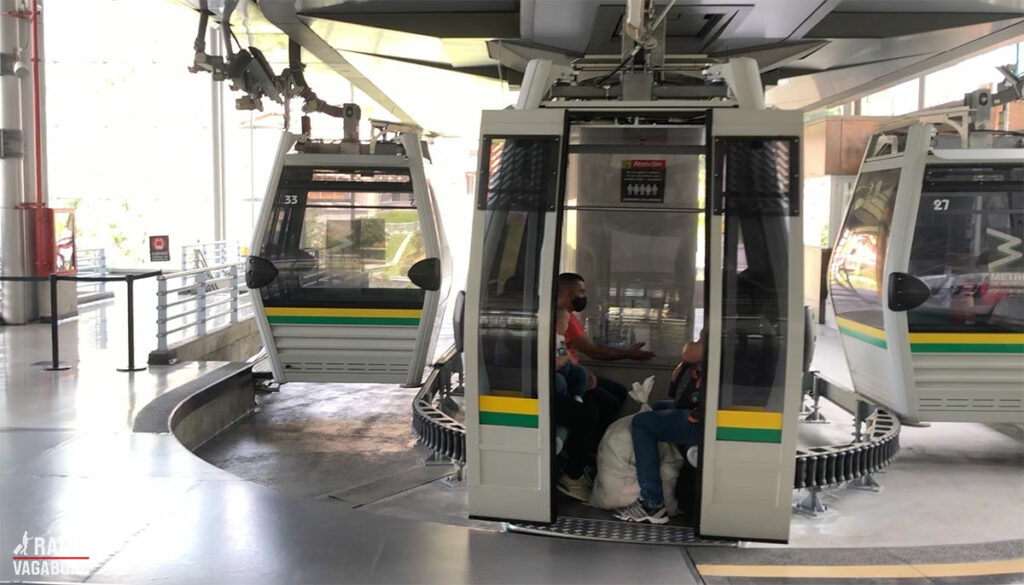
4. BIG OUTDOOR ESCALATOR
Medellín is surrounded by mountains so getting public transport to the steepest corners of the city isn’t easy. So, the city planners got a bright idea: They decided to build an outdoor escalator. The Comuna 13 neighbourhood is on a steep hillside – and before the people living here had to climb the equivalent of 28 stories to get home from the city centre. Now, the journey takes six minutes, and the views get increasingly impressive as you glide up the hill.
5. MEDELLÍN AWARDED THE MOST INNOVATIVE CITY OF 2013
The Urban Land Institute awarded Medellín “the Innovative City of the Year award” in 2013. Tramways, cable cars and the outdoor escalators were a big part of this, but also the city’s world-class art galleries, libraries, and public spaces. Later, in 2016, Medellín won the Lee Kuan Yew World City Prize, a sort of “urbanism Nobel prize”. Medellín got this because of its transformation into an outstanding liveable city.
6. MEDELLÍN IS NOT A DANGEROUS CITY ANYMORE
Twenty-five years ago, Time magazine dubbed Medellin “the most dangerous city on earth”. It was here that Pablo Escobar had his Medellín Cartel – a powerful and highly organized Colombian drug cartel and terrorist-type criminal organization. Escobar and other drug lords lived like princes. Judges and policemen were assassinated on a daily basis, and ordinary people disappeared overnight without trace.
You might have seen Narcos on Netflix that tells the story of the life of Pablo Escobar and the rise and fall of the Medellín Cartel. By the way, it’s important to say that this is fiction and according to the locals only partly a true story.
Pablo Escobar was killed in 1993, yet still many people to this day think that Colombia and especially Medellín is a dangerous place to visit. But since then, the city has been transformed. Obviously, it’s a big city and not without problems; but it’s really not more dangerous than any other big city.
7. FROM MURDER CAPITAL TO NOMAD HOTSPOT
So, Medellín went from the murder capital of the world to a hipster holiday destination and a digital nomad hotspot.
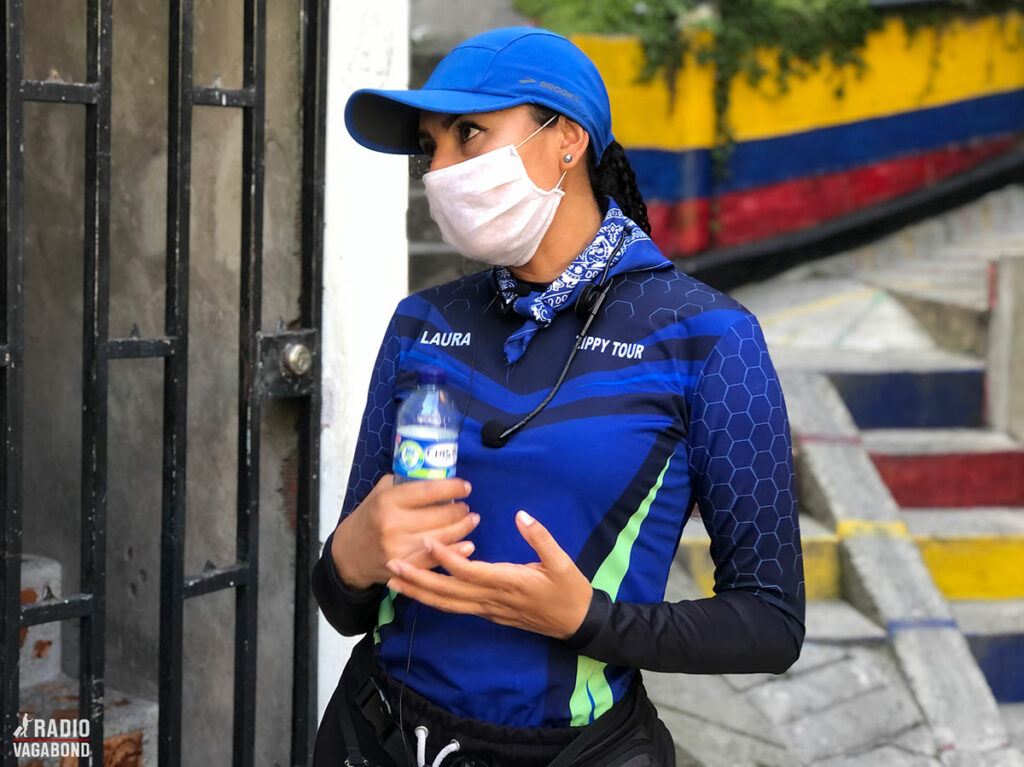
VISITING COMUNA 13
Comuna 13 is famous for the outdoor escalator but just as much for its amazing street art. Local artists are responsible for the colourful murals.
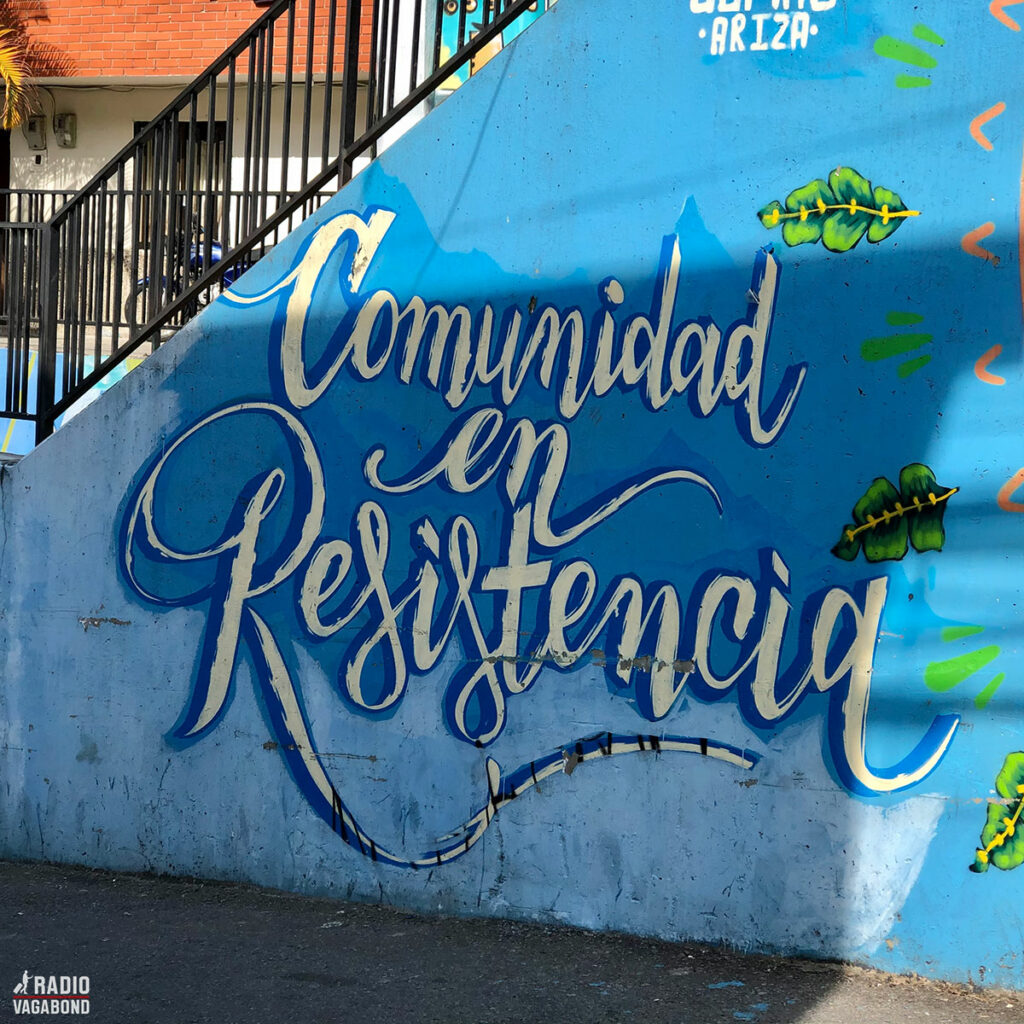
Back in the day, Comuna 13 was the most dangerous district in the most dangerous city in the world. And it actually only got worse after Escobar was killed. The real violence in Comuna 13 only started after his death in 1993. The power vacuum created a bloody battle between left-wing guerrilla, right-wing paramilitary groups, and local street gangs.
They all wanted to take control over Comuna 13, and between 1997 and 2002 the murder rate in Medellín tripled. The district was divided into zones of guerrillas and the paramilitary. There were ‘invisible borders’ everywhere, and if you crossed one, it could mean the difference between life and death.
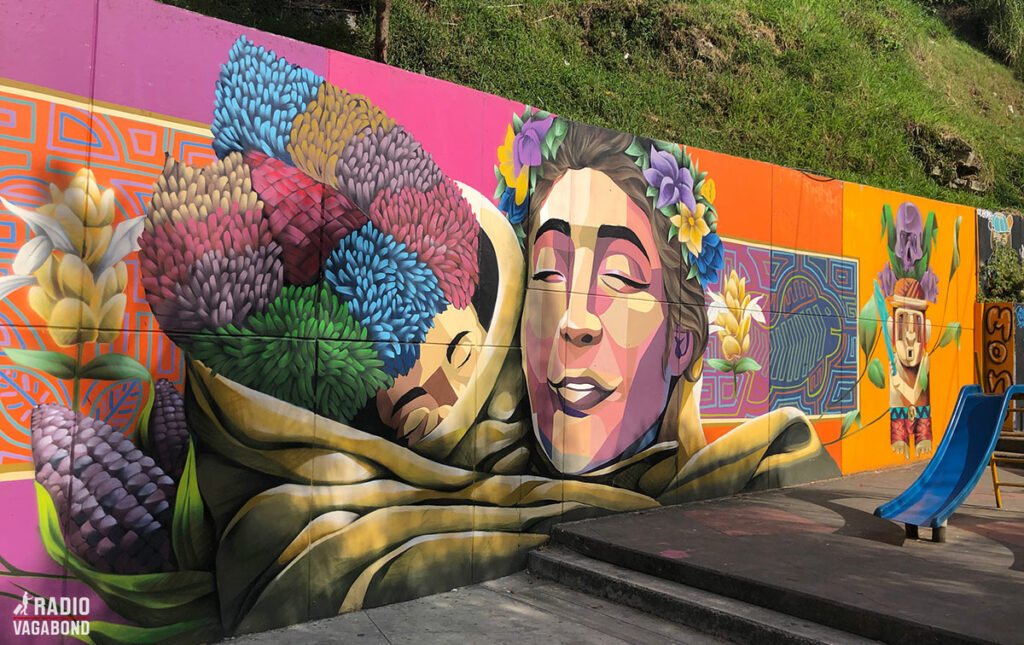
If you had said just 15 years ago that you were going to Comuna 13, people would have thought you were crazy. And that’s where I’m going next.
Still today, it is not 100% safe, but this district is on the road to recovery. One of the positive influences is the Comuna 13 street art.
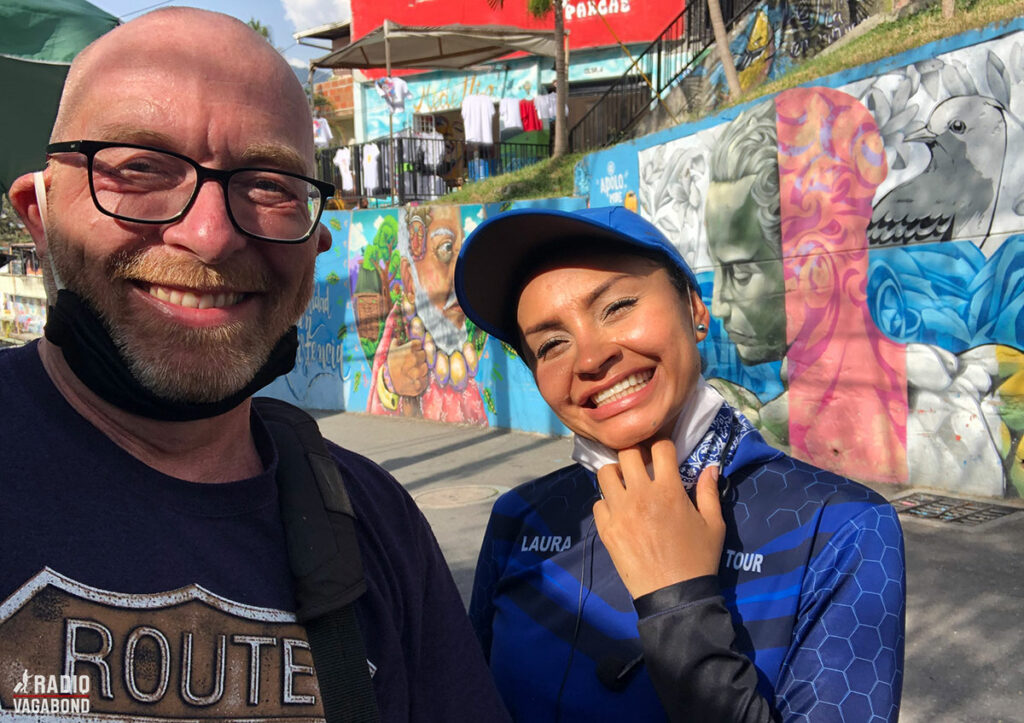
TOURING COMUNA 13
I signed up for a 2.5-hour tour of Comuna 13 to experience the urban art, dance, and hear some amazing stories see the transformation of this district with my own eyes.
For years, Comuna 13 was considered one of the most dangerous areas in Colombia but today it’s an awesome example of change.
My local guide, Laura, works for Zippy Tour and lives in the area and we ended the tour at the house she lives in with her family – way up the hill of Comuna 13.
Before the tour started, Laura asked us not to give the local children any money as there are more than enough opportunities for them to earn money and giving them a ‘hand out’ will not incentivise them to take these opportunities available to them. And many of them will use the money to purchase drugs as drug use remain a problem in this area.
“We’ve been doing tours here for the past 5 years. We want to show people the beauty of Comuna 13 and the stores behind the art, the community, and the history of violence that has been transformed in recent years. Unfortunately, our tour business has suffered due to Covid-19 but we are so happy to still receive tourists despite the situation.”
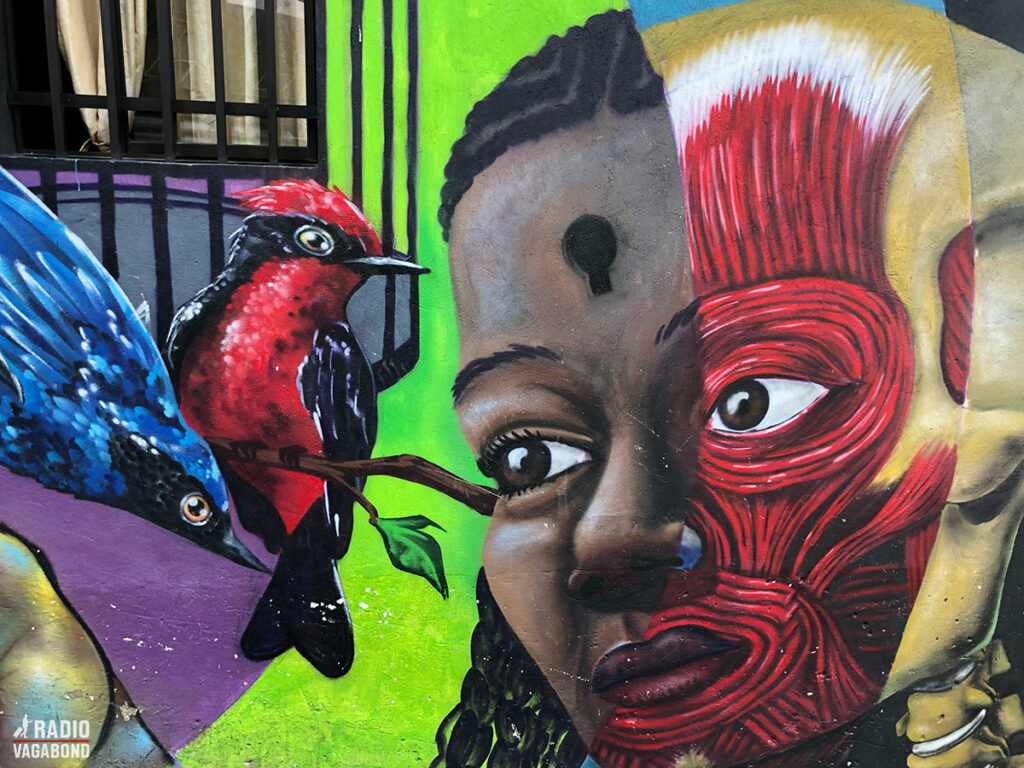
LIFE IN COMUNA 13
Laura has lived here in Comuna 13 her entire life. Her parents got married when they were very young.
“My mother was 15 and my father was 18 when they got married because back then there was an agreement between families who had many children. For example, my father had 19 siblings and my mother had 21 siblings. It was a way to get them out of the house quickly to become financially independent.”
Her parents were very poor and couldn’t afford to buy land or a house. But at the time – around the start of the 1980s – the government began giving free land in Comuna 13 which her parents acquired.
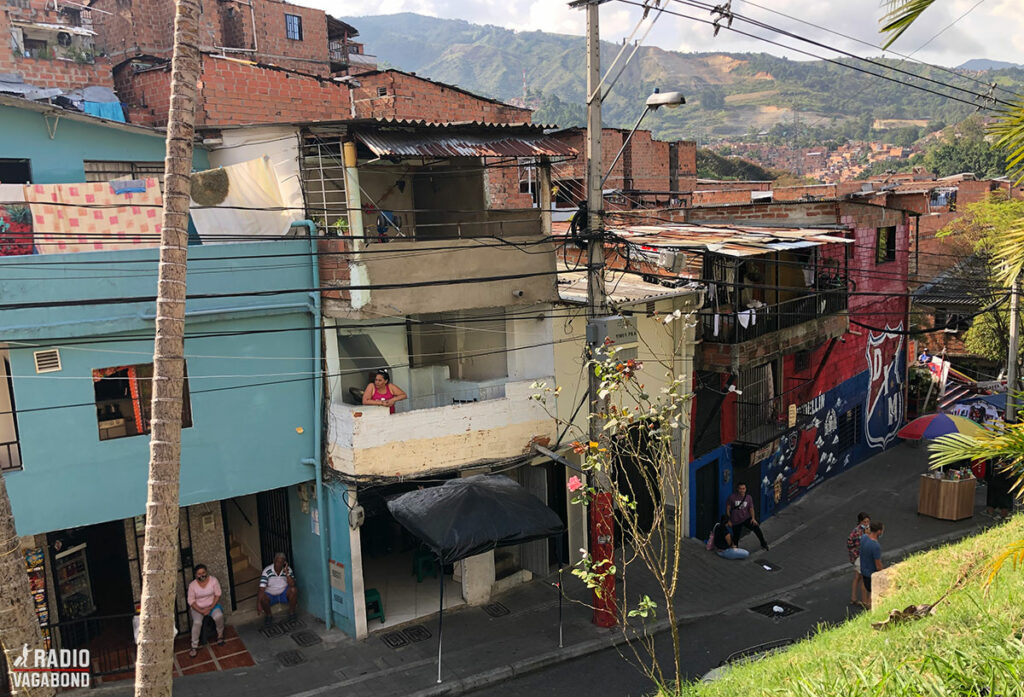
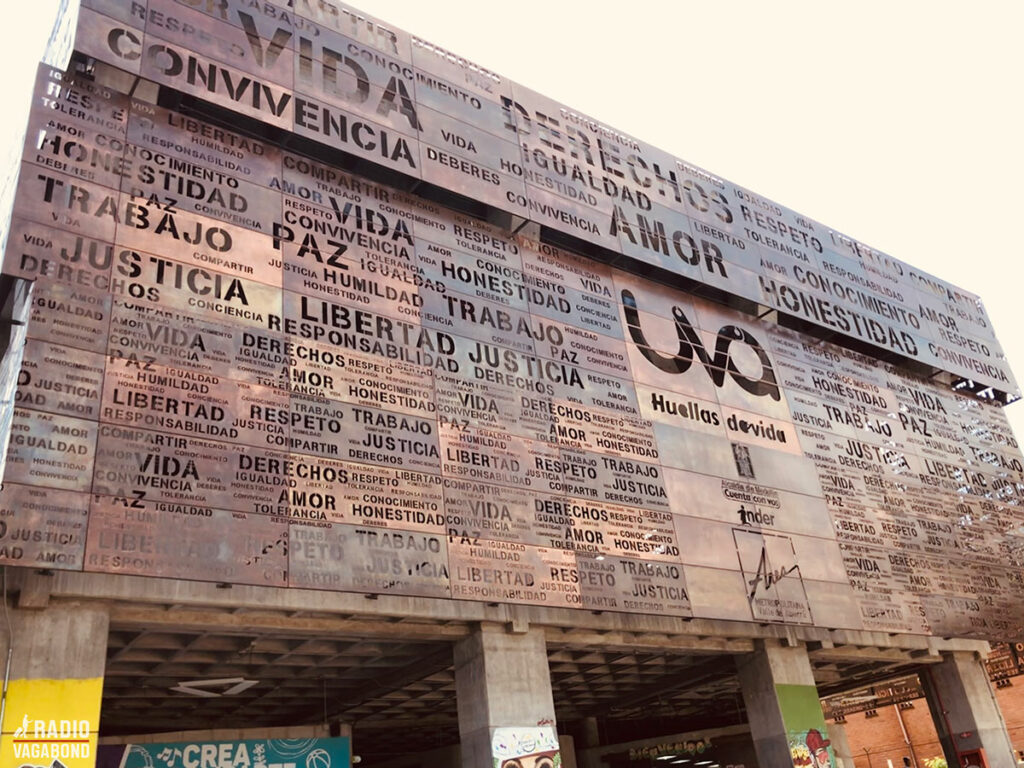
So, Laura has fond memories of living here when she was a girl in the ’80s. And the invisible borders I was talking about earlier first came later. So, she didn’t see any dead people in the streets, the quality of life when it comes to health was very bad.
“The situation was bad, but the community made it a pleasant place to live. They held fiestas and concerts, and I have fond memories of growing up here.”
Laura explained that it was like a forgotten part of the city. It was just poor people living here, so it was like the government didn’t care about them. Laura told us that as a girl, she never once saw any police presence in the area ever.
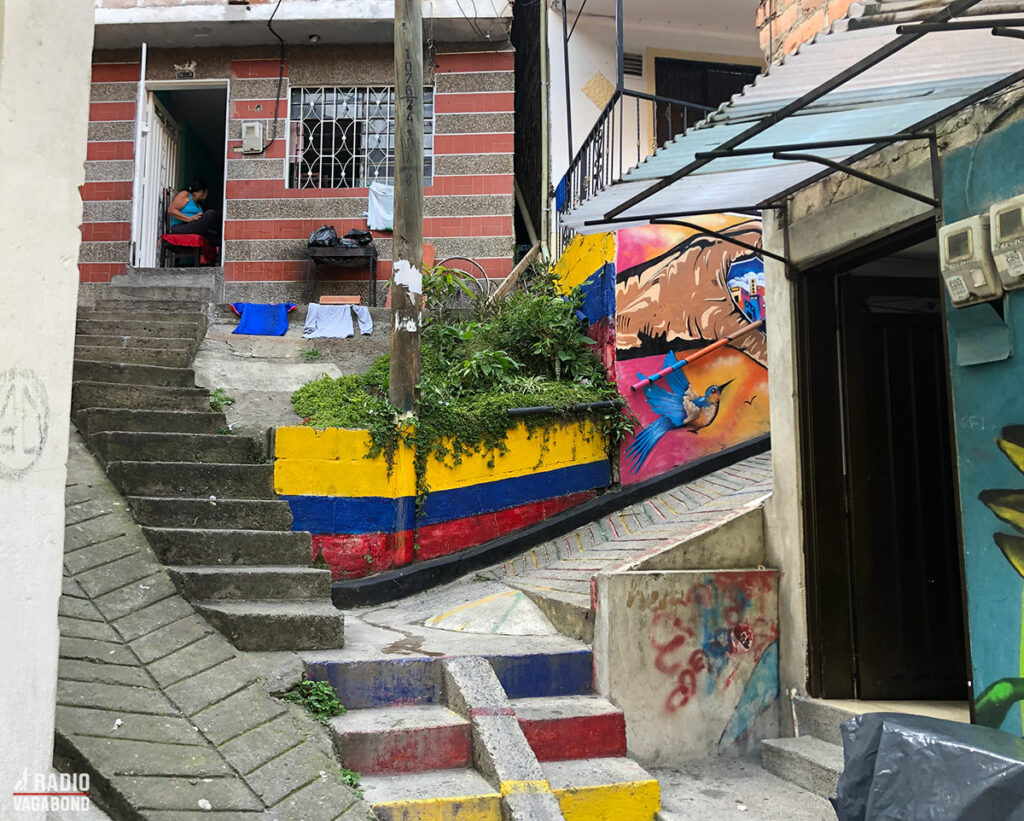
The locals decided to create their own illegal security protection group called the Popular Militias. They started out well, taking care of the community and protecting the children from nefarious activities at night. However, over time, the Popular Militias began to become dangerous and everything changed when Pablo Escobar died.
Yes, everything would change when Pablo Escobar died in 1993. At the time Laura was around 11 years old. And as we talked about earlier, this was when things turned really bad here in Comuna 13.
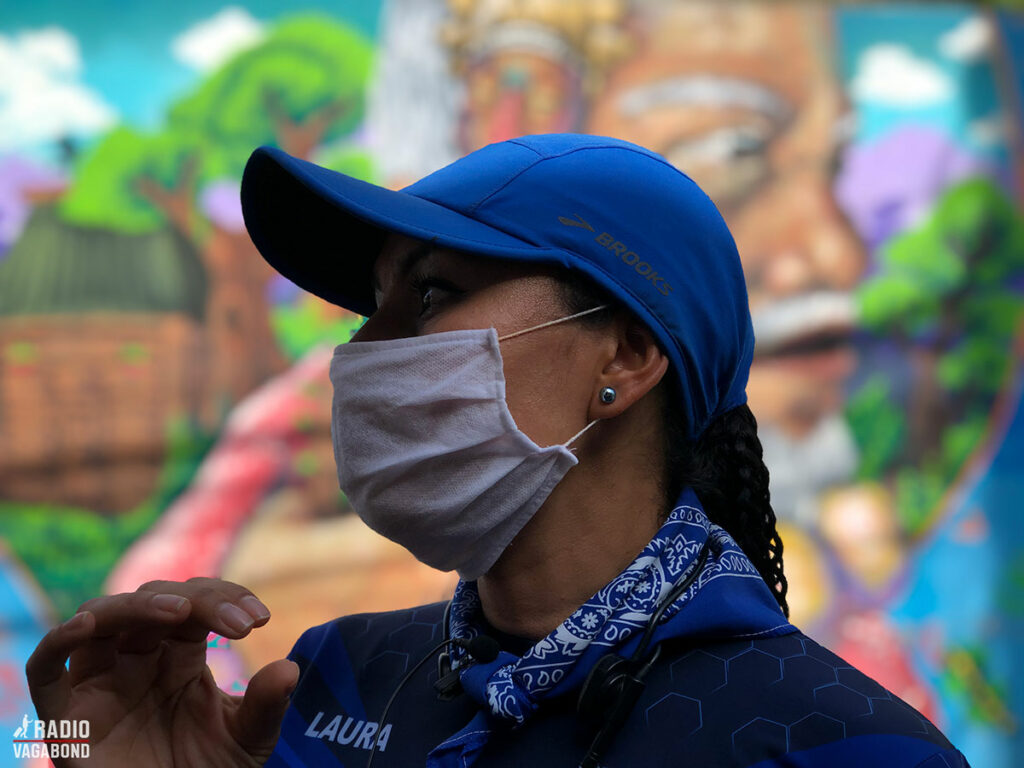
When Escobar was at his peak with the Medellín Cartel he recruited a lot of young people in Comuna 13.
“Escobar’s cartel began recruiting young people from poor neighbourhoods around the city, including here in Comuna 13, to work in their organisation. Often, this included crimes such as kidnapping, torture, assassinations, local terrorism, and drug trafficking.
Escobar even offered 1 million Colombian pesos for every policeman killed, which of course made many poor and disadvantaged people eager to get involved in a life of crime. It was easy, fast money. Escobar was responsible for arranging the killing of 657 policemen in Medellín.”
And as you might remember, the hunt for Pablo Escobar ended when he was shot on a roof in Comuna 11, not far from here.
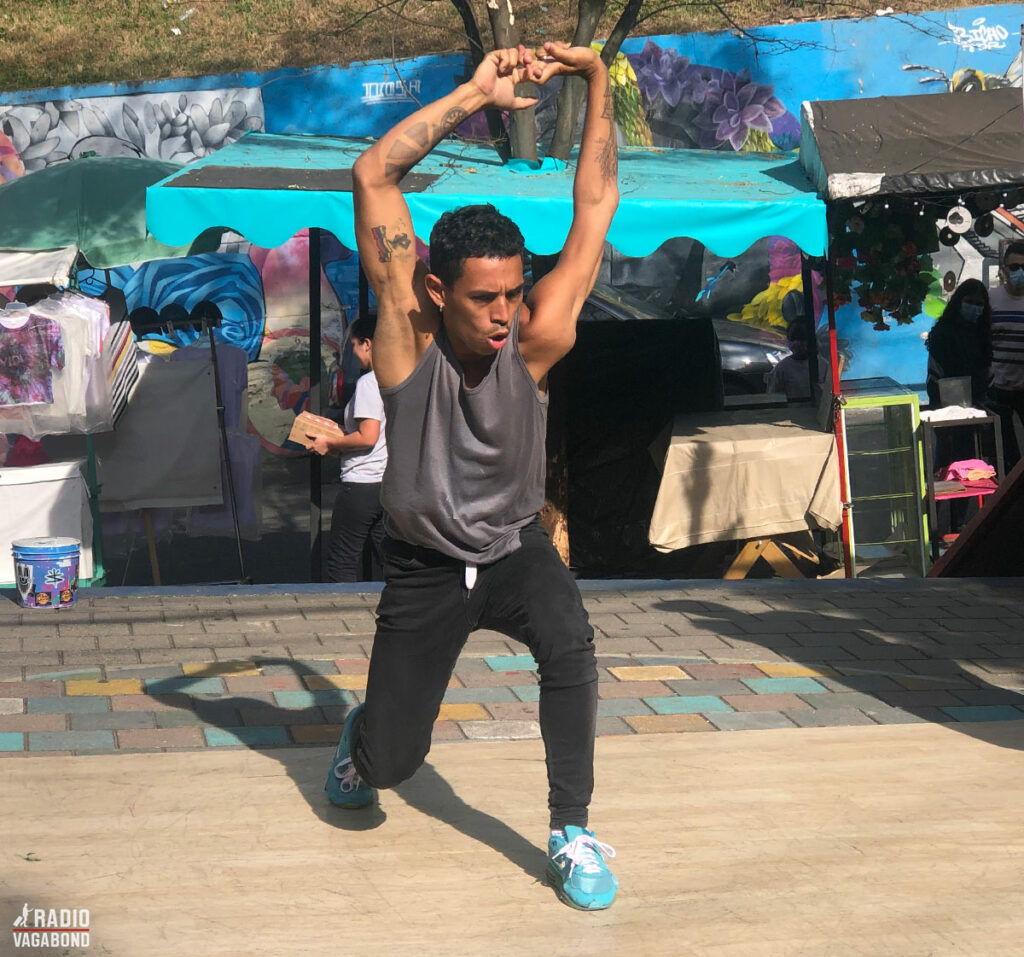
“The government thought that once Escobar was dead, things would be better. This was not the case. Many people and crime organisations wanted to take control and the violence spread rapidly throughout the country. Many criminal syndicates joined forces and urban warfare was rampant. Many innocent people lost their lives.”
During that time, the government had many operations to get law and order brought to Comuna 13. They all failed. So, in October 2002 they did a more drastic operation. Operation Orion was “the largest urban military operation ever to take place in Colombia” and lasted for four days.
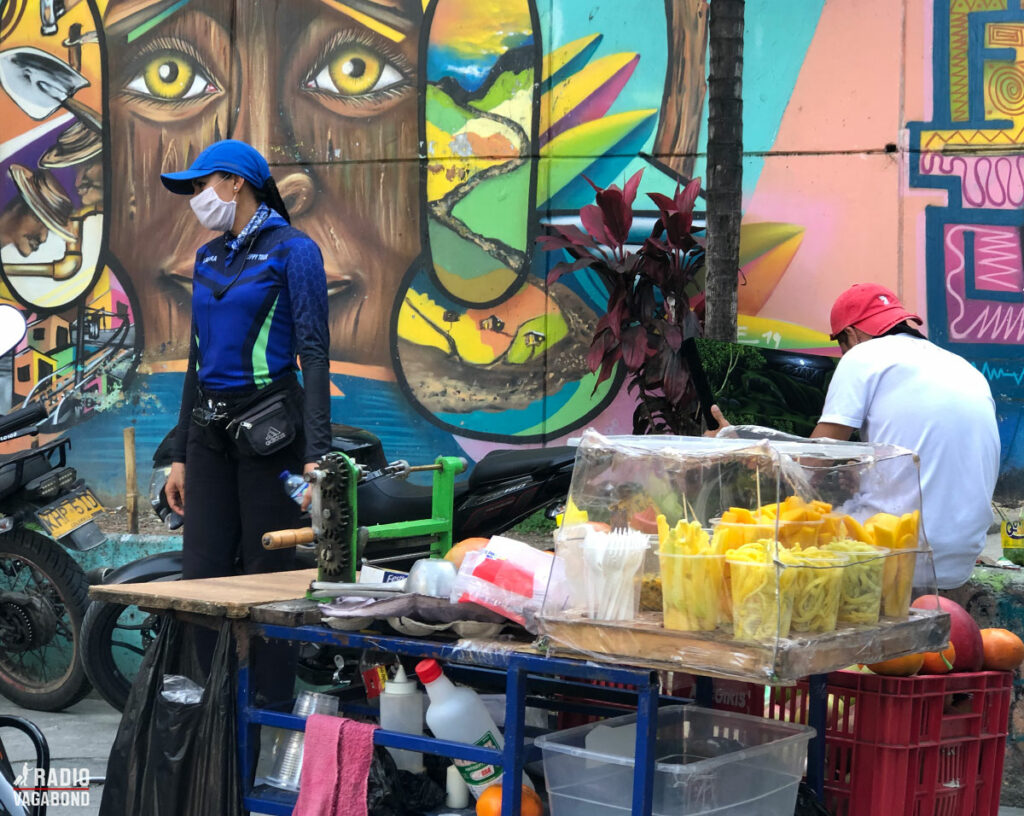
WARM COLOMBIAN HOSPITALITY
We continued to Laura’s home and had cold beer on the balcony with a stunning view of Comuna 13 and Medellín. On the way, we saw a lot of amazing street art and was witness to several dance acts.
Even though a part of it was on the escalators, it was still a lot of walking uphill.
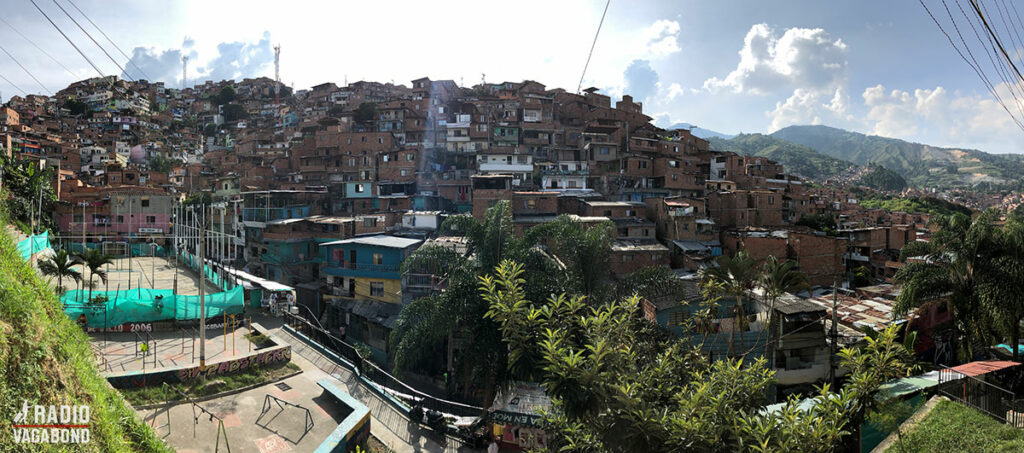
I chatted to Laura and found out more about life living in Comuna 13 and sharing a home with so many siblings and family members.
Before I put my microphone away and enjoyed the view and chats with new friends, Laura had some final words about her country.
“Colombia is more than coffee and Narcos. Colombia has so much to offer both locals and visitors alike. We have a beautiful paradise filled with wonderfully warm people.”
Amen to that, Laura.
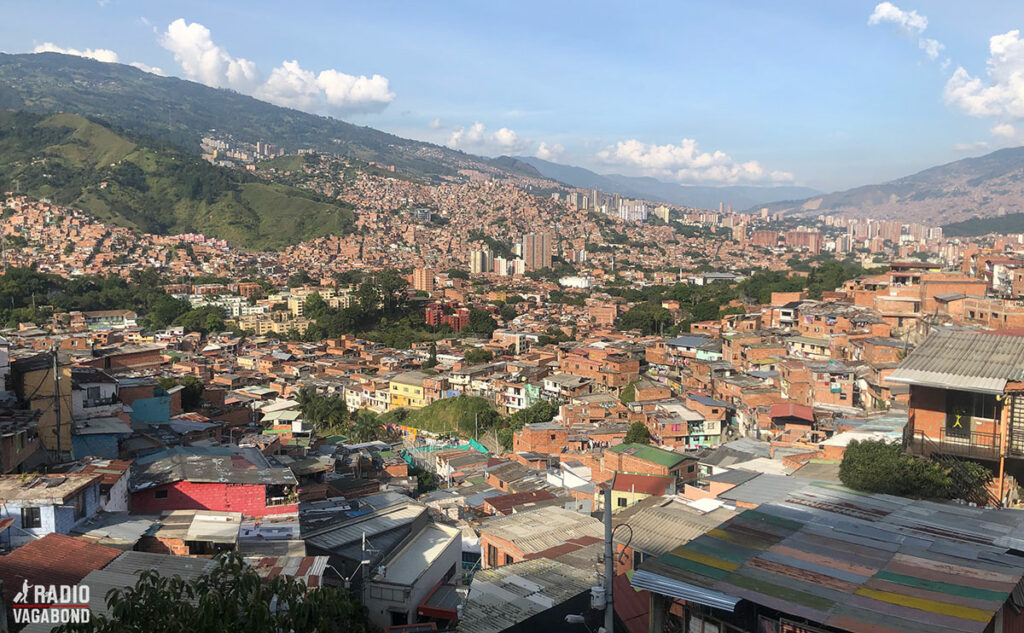
My name is Palle Bo, and I gotta keep moving. See you.
COVID-19 TRAVEL and TOURISM RULES FOR COLOMBIA
For the latest COVID-19 travel restrictions and tourist regulations, please visit the official website of the Colombian government. Make sure the Colombia is open for tourism before booking your trip.
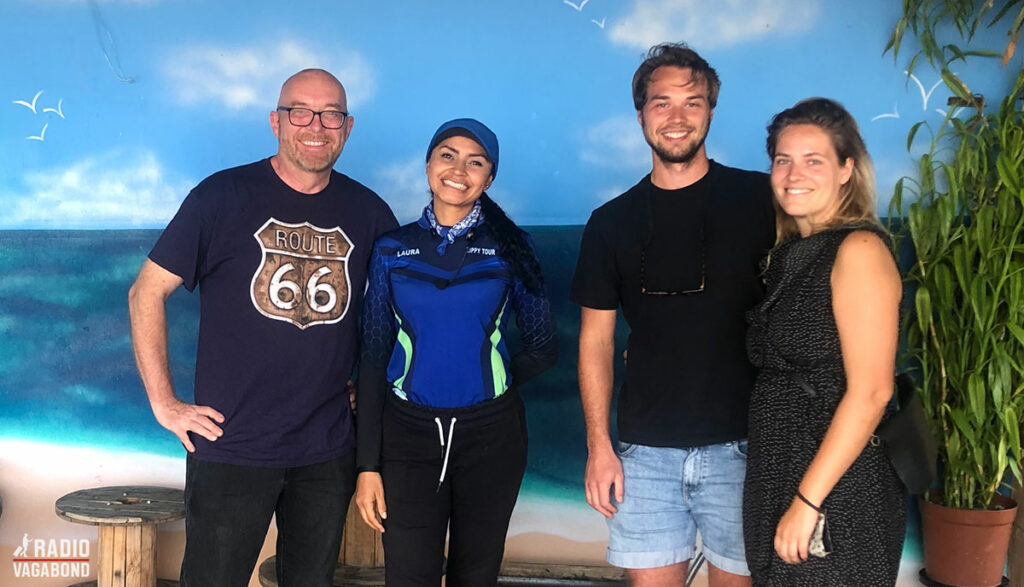
I WOULD LIKE TO HEAR FROM YOU!
Please tell me where are you and what are you doing as you listen to this episode? You can either send me an email on listener@theradiovagabond.com, go to TheRadioVagabond.com/Contact or send me a voice message by clicking on the banner.
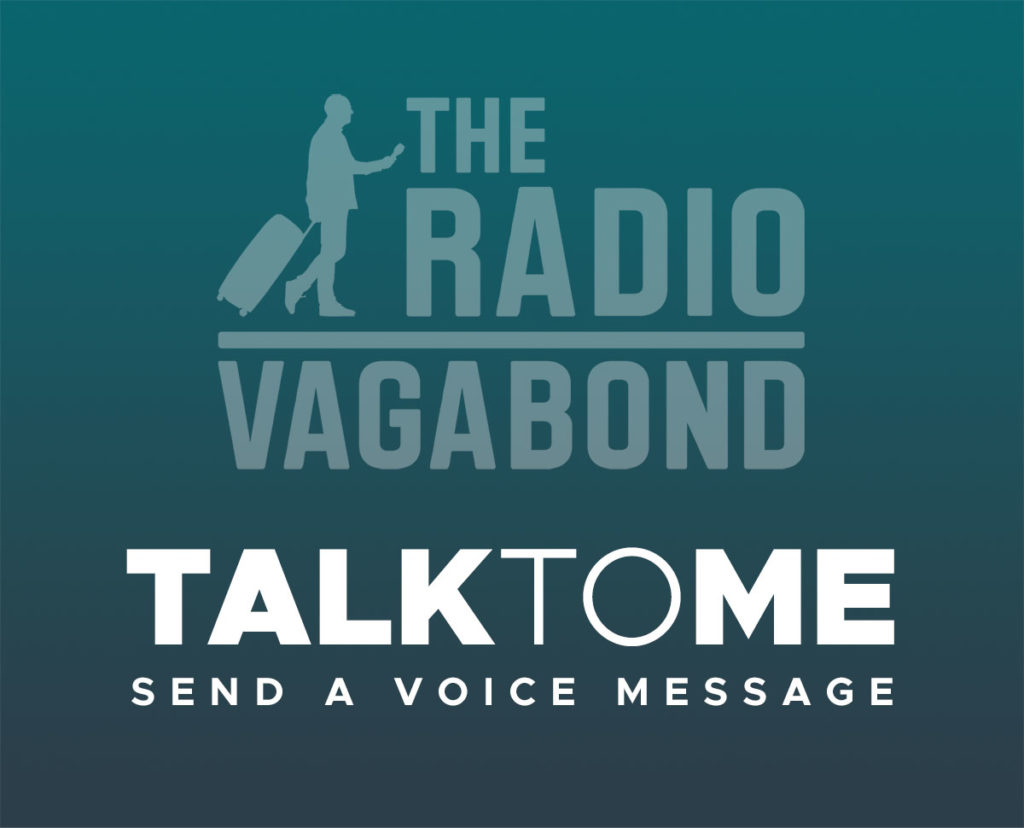
Either way, I would love to hear from you. It’s so nice to know who’s on the other end of this.
SPONSOR
A special thank you to my sponsor, Hotels25.com, who always provide me with the best, most affordable accommodation wherever I am in the world.
Hotels25 scans for prices on the biggest and best travel sites (like Booking.com, Hotels.com, Agoda and Expedia) in seconds. It finds deals from across the web and put them in one place. Then you just compare your options for the same hotel, apartment, hostel or home and choose where you book.
When you book with Hotels25, you get access to 5,000,000 hotel deals. And it’s “best price guaranteed.”
The Radio Vagabond is produced by RadioGuru. Reach out if you need help with your podcast.

